
Subtittle if needed. If not MONTH 2018
Published in Month 2018
Accelerating Wind Turbine
Blade Circularity
May 2020

windeurope.org
Published May 2020
Accelerating
Wind Turbine
Blade Circularity
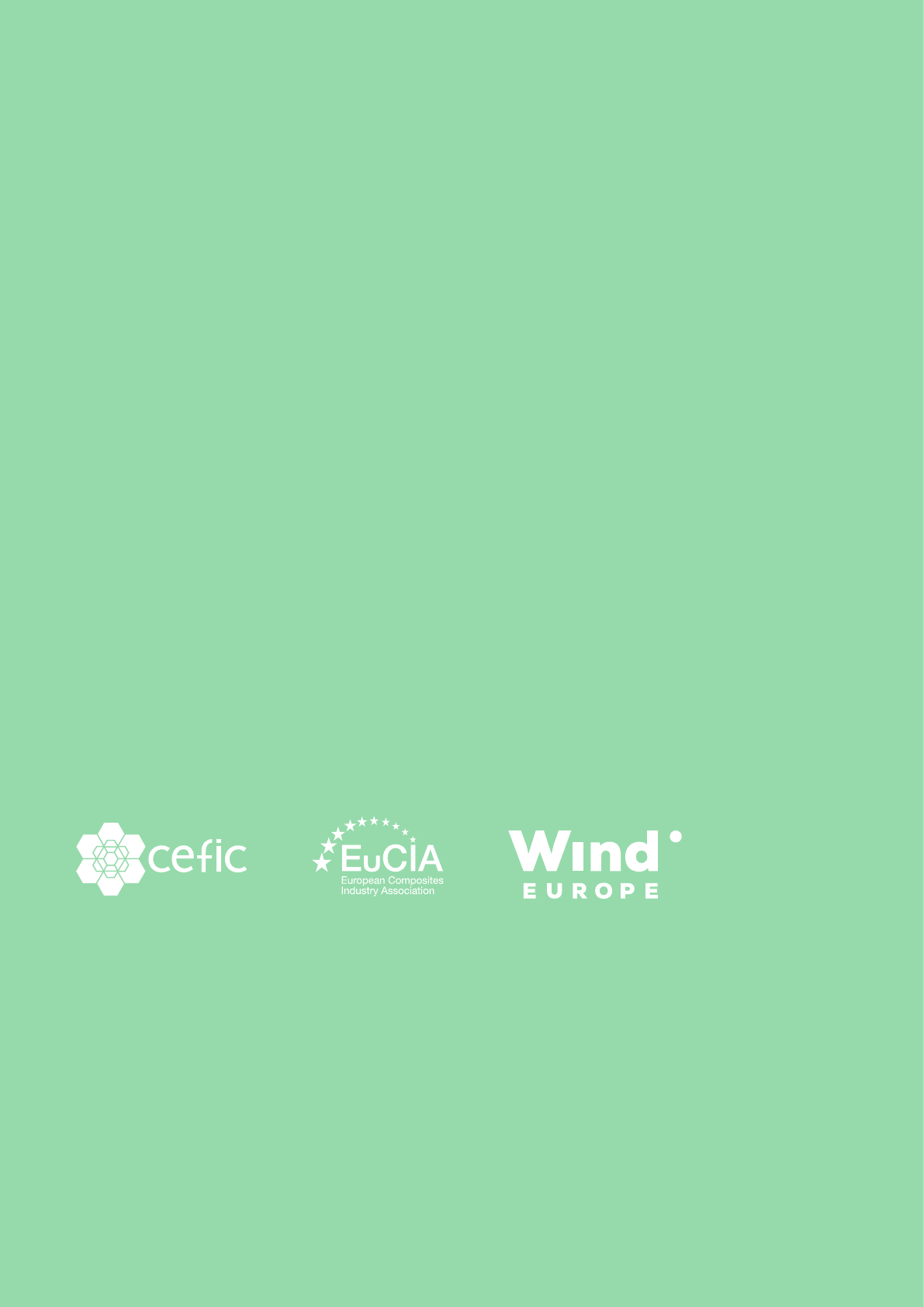
TEXT AND ANALYSIS:
Marylise Schmid, WindEurope
Nieves Gonzalez Ramon, Cec
Ann Dierckx, Cec
Thomas Wegman, EuCIA
EDITORS:
Daniel Fraile, WindEurope
Colin Walsh, WindEurope
DESIGN:
Lin van de Velde, Drukvorm
PHOTO COVER:
Damon Hong
MORE INFORMATION:
Sustainability-Pla[email protected]
+32 2 213 18 11
This report has been jointly prepared by WindEurope, Cec and EuCIA through a collaborave cross-
sector plaorm on wind turbine blade recycling. Notably, the report:
• describes wind turbine blade structure and material composion;
• highlights the expected volumes of composite waste, including wind turbine blade waste;
• maps the exisng regulaons governing composite waste in Europe;
• describes the exisng recycling and recovery technologies for treang composite waste as well as
innovave applicaons for using composite waste; and
• provides recommendaons for research and innovaon to further enhance the circularity of wind
turbine blades and design for recycling.
This report is intended for general informaon only and, whilst its contents are provided in utmost
good faith and are based on the best informaon currently available, is to be relied upon at the user’s
own risk. No representaons or warranes are made with regards to its completeness or accuracy and
no liability will be accepted by the authors.
We would like to thank members of WindEurope Sustainability WG for their dedicated review and input.
In parcular: Siemens Gamesa Renewable Energy, LM Wind Power, TPI Composites, GE Renewable
Energy, MHI Vestas, Vaenfall, Vestas, Nordex, EDF Renouvelables, Engie and Ørsted.

CONTENTS
EXECUTIVE SUMMARY .....................................................................................................5
1. INTRODUCTION ....................................................................................................................7
1.1. CROSS-SECTOR PLATFORM .................................................................................8
1.2. OBJECTIVES ..................................................................................................................8
1.3. CONTEXT .........................................................................................................................8
2. COMPOSITES & THE WIND INDUSTRY .....................................................................10
2.1. INTRODUCTION ............................................................................................................10
2.2. BLADE STRUCTURE & MATERIAL COMPOSITION .......................................11
2.3. FUTURE TRENDS IN BLADE MATERIALS .........................................................12
3. MARKET OUTLOOK .............................................................................................................14
3.1. AN AGEING ONSHORE WIND FLEET ..................................................................14
3.2. COMPOSITE WASTE: A CROSSSECTOR CHALLENGE ...........................15
4. LEGISLATIVE CONTEXT ....................................................................................................17
4.1. INTRODUCTION ............................................................................................................17
4.2. COMPOSITE WASTE CLASSIFICATION ...........................................................17
4.3. EXISTING LEGISLATION ...........................................................................................18
5. BLADE WASTE TREATMENT METHODS ..................................................................20
5.1. THE WASTE HIERARCHY .........................................................................................20
5.2. RECYCLING AND RECOVERY TREATMENT METHODS ..............................25
5.3. CONCLUSION ................................................................................................................31
6. TAKING BLADE RECYCLING TO THE NEXT LEVEL ..............................................32
REFERENCES .........................................................................................................................34
APPENDIX A. ADDITIONAL RESOURCES ................................................................35
4
Accelerating Wind Turbine Blade Circularity - 2020
WindEurope – Cefic - EuCIA
5
Accelerating Wind Turbine Blade Circularity - 2020
WindEurope – Cefic - EuCIA
As the wind industry connues to grow to provide renew-
able energy across the globe, we are commied to pro-
mong a circular economy which reduces environmen-
tal impacts throughout product lifecycles. To this end,
WindEurope (represenng the wind energy industry),
Cec (represenng the European Chemical Industry) and
EuCIA (represenng the European Composites Industry)
have created a cross-sector plaorm to advance ap-
proaches for the recycling of wind turbine blades, includ-
ing technologies, processes, waste ow management, re-
integraon in the value chain and logiscs.
Today around 85 to 90% of wind turbines’ total mass can
be recycled
[1], [2], [3]
. Most components of a wind turbine
– the foundaon, tower and components in the nacelle
– have established recycling pracces. However, wind
turbine blades are more challenging to recycle due to
the composite materials used in their producon. While
various technologies exist to recycle blades, and an in-
creasing number of companies oer composite recycling
services, these soluons are not yet widely available and
cost-compeve.
EXECUTIVE
SUMMARY
6
Accelerating Wind Turbine Blade Circularity - 2020
WindEurope – Cefic - EuCIA
Executive summary
Wind turbine blades are made up of composite materials
that boost the performance of wind energy by allowing
lighter and longer blades with opmised aerodynamic
shape. Today 2.5 million tonnes of composite material are
in use in the wind energy sector globally
[1]
. WindEurope
esmates around 14,000 blades could be decommis-
sioned by 2023
[4]
, equivalent to between 40,000 and
60,000 tons. Recycling these old blades is a top priority for
the wind industry. This requires logiscal and technologi-
cal soluons for disassembling, collecon, transportaon,
waste management and reintegraon in the value chain.
Composite recycling is not solely a challenge for the wind
industry but rather a cross-sector challenge. Blade waste
will represent only 10% of the total esmated thermoset
composite waste by 2025. The relavely low volumes of
composite blade waste make it challenging to build a re-
cycling business based only on this waste stream. Acve
engagement from all the composite-using sectors and
authories will be required to develop cost-eecve solu-
ons and strong European value chains.
Exisng European waste legislaon emphasises the need
to develop a circular economy and increase recycling rates
to deal with unnecessary waste polluon and increase re-
source eciency. At naonal level, Germany, Austria, Fin-
land and the Netherlands forbid composites from being
landlled. France is considering introducing a recycling
target for wind turbines in its regulatory framework due
to be updated in 2020. Going forward there may be more
harmonisaon of guidelines and legislaon, which would
be more ecient for the development of a pan-European
market for recycling blade waste. The wind industry is cur-
rently working on a proposal for an internaonal guide-
line for the dismantling and decommissioning of wind
turbines.
Today, the main technology for recycling composite waste
is through cement co-processing. Cement co-processing
is commercially available for processing large volumes of
waste (albeit not in all geographies yet). In this process
the mineral components are reused in the cement. How-
ever, the glass bre shape is not maintained during the
process, which from a waste hierarchy perspecve may be
less preferred. WindEurope, Cec and EuCIA strongly sup-
port increasing and improving composite waste recycling
through the development of alternave recycling tech-
nologies which produce higher value recyclates and ena-
ble producon of new composites. Further development
and industrialisaon of alternave thermal or chemical
recycling technologies may provide composite-using sec-
tors, such as building & construcon, transportaon, ma-
rine and the wind industry, with addional soluons for
end-of-life.
Europe needs to invest on more research and innovaon
to diversify and scale up composite recycling technolo-
gies, to develop new, high-performance materials with
enhanced circularity, and to design methodologies to en-
hance circularity and recycling abilies of blades. At the
same me exisng treatment routes like cement co-pro-
cessing must be deployed more widely to deal with the
current waste streams. Finally, the scienc understand-
ing of the environmental impacts associated with the
choice of materials and with the dierent waste treatment
methods should also be improved (life cycle assessment).

7
Accelerating Wind Turbine Blade Circularity - 2020
WindEurope – Cefic - EuCIA
1.1 CROSSSECTOR PLATFORM
In 2019, WindEurope, Cec (the European Chemical In-
dustry Council) and EuCIA (the European Composites
Industry Associaon) created a cross-sector plaorm to
advance novel approaches to the recycling of wind tur-
bine blades, including technologies, processes, waste ow
management, reintegraon in the value chain and logis-
cs. In parcular, this cross-sector plaorm aims to un-
derstand the potenal of exisng wind turbine blade recy-
cling technologies and ensure recycling is factored in wind
turbine blade design. This report supports this eort.
1.
INTRODUCTION
“Wind energy is an increasingly important part of Europe’s energy mix. The rst generaon of wind
turbines are now starng to come to the end of their operaonal life and be replaced by modern
turbines. Recycling the old blades is a top priority for us, and teaming up with the chemical and
composites industries will enable us to do it the most eecve way.”
- Giles Dickson, WindEurope CEO
“The chemical industry plays a decisive role in the transion to a circular economy by invesng in
the research and development of new materials, which make wind turbine blades more reliable,
aordable and recyclable. Innovaon is born from collaboraon and we look forward to working
together to advance wind turbine blade recycling.”
“The wind energy sector has always been at the forefront of using composites as they are
instrumental to sustainable energy generaon. With this collaboraon we hope to set a great
industry standard that ulmately will also help customers in other industries like marine and
building & infrastructure.”
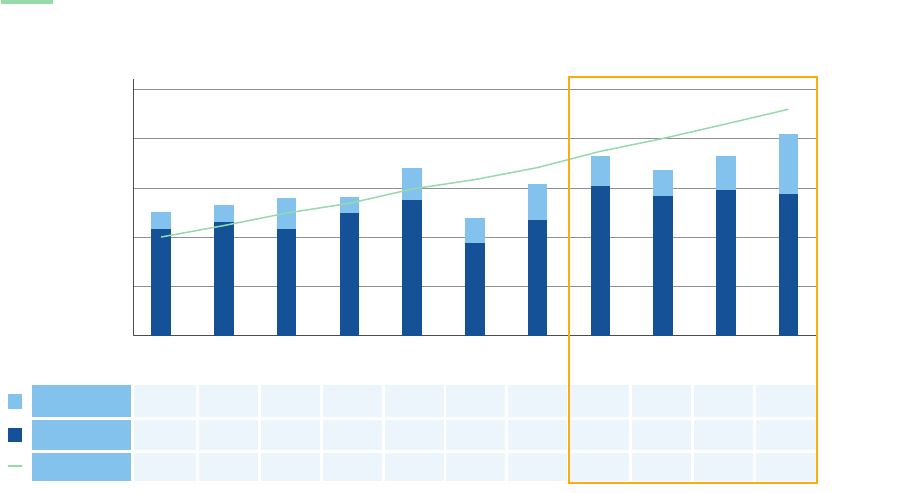
8
Accelerating Wind Turbine Blade Circularity - 2020
WindEurope – Cefic - EuCIA
Introduction
1.2 OBJECTIVES
The cross-sector plaorm conducted a series of work-
shops in 2019 during which new examples of blade repur-
posing and recycling were presented. Since WindEurope’s
2017 publicaon on managing composite blade waste
[5]
,
some Member States have also started to consider legisla-
on on decommissioning and on blade circularity.
The objecve of this report is to present the state-of-
play in the recycling of composites used in wind turbine
blades. The report is based on the ndings of those recent
workshops. Notably, the report:
• describes wind turbine blade structure and material
composion;
• highlights the expected volumes of composite waste,
including wind turbine blade waste;
• maps the exisng regulaons governing composite
waste in Europe;
• describes the exisng recycling and recovery
technologies for treang composite waste as well as
innovave applicaons for using composite waste;
and
• provides recommendaons for research and
innovaon to further enhance the circularity of wind
turbine blades, including new materials and design
for recycling.
This report supplies relevant and praccal informaon on
the subject and promotes the sustainable management of
composite blade waste. Research on the subject is ongoing
and with this comes the challenge of keeping up to date
with the state-of-the-art. If you have further input please
nofy us at Sustainability-Pla[email protected].
1.3 CONTEXT
In 2019 wind energy supplied 15% of the EU’s electricity
[6]
. This number will connue to grow in the coming years
(Figure 1). The EU’s binding target for increasing the re-
newable energy share to 32% by 2030, and its commit-
ment to becoming carbon-neutral by 2050, emphasises
wind power’s important role in the future energy mix. The
European Commission (EC), in their long-term decarbon-
isaon strategy to 2050, esmates that wind alone could
provide 50% of the EU’s electricity demand by 2050. And
importantly, this demand will be signicantly higher than
today’s level, as society increases the electricaon of en-
ergy uses.
Source: WindEurope
2013 2014 2015 2016 2017 2018 2019 2020 2021 2022 2023
0
50
100
150
200
250
0
50
100
150
200
250
300
Gross installations (GW)
Cumulative capacity (GW)
Offshore
Onshore
Cumulave
1.5 1.5 3.0 1.6 3.2 2.7 3.6 2.9 2.7 3.4 5.9
11.0 11.6 10.9 12.3 13.9 9.4 11.7 15.2 14.2 14.7 14.5
122 135 148 162 178 190 205 222 238 255 275

9
Accelerating Wind Turbine Blade Circularity - 2020
WindEurope – Cefic - EuCIA
Introduction
In the future, a growing amount of wind turbines will start
to be decommissioned, considering that:
• The standard lifeme of a wind turbine is
approximately 20-25 years, with some wind turbines
now reaching up to 35 years through lifeme
extension;
• There are increasing repowering opportunies i.e.
replacing old models with newer and more ecient
models, that can increase wind farm electricity
output by a factor of 2.
Many of the wind turbines installed in the 1990s are of
a few hundred kW and are under 60m in hub height. If
replaced by taller and more powerful turbines, the in-
crease in energy yields could be considerable. Indeed, the
analysis of more than 100 repowering projects in Europe
has shown that, on average, the number of turbines de-
creases by a third whilst wind farm capacity more than
doubles
[7]
.
The wind industry is commied to promong a more cir-
cular economy and determining ways in which it can sup-
port this. A sustainable process for dealing with wind tur-
bines at the end of their service life is needed to maximise
the environmental benets of wind power from a life cycle
approach (Figure 2). To do so, the wind industry is acvely
looking for industries and sectors that can make use of
the materials and equipment decommissioned from wind
farms. And the wind industry wants to work with them to
build capacies in wind turbine blade circularity, including
through the development of new, more easily recyclable
structural design and materials.
Source: WindEurope
If countries enable the repowering of an increas-
ing amount of old wind turbines,
Repowering or life
time extension
(optional)
Decommissioning &
waste treatment
Operation &
Maintenance
Transportation
& Installation
Manufacturing
Raw material
extraction
End of Life strategies
EOL
10
Accelerating Wind Turbine Blade Circularity - 2020
WindEurope – Cefic - EuCIA
2.1 INTRODUCTION
Today around 85 to 90% of a wind turbine’s total mass
can be recycled
[1], [2], [3]
. Most components of a wind tur-
bine such as the foundaon, tower and components in
the nacelle have established recycling pracces. And the
raw materials of these components have enough value
for secondary markets. For example, the steel in towers
is 100% recyclable
[8]
. It can be reused again without any
loss of quality. Steel scrap is regarded as a valuable raw
material for steel producon. Because of its value, there is
a well-established market for steel scrap.
Treatment of foundaons during decommissioning diers
from country to country. In some countries, foundaons
need to be removed. The concrete from removed founda-
ons can be recycled into aggregate for building materials
or road construcon. In other countries, foundaons may
be (partly or fully) le in-situ where removal would lead
to higher environmental impacts or if the land owner has
specied so.
Wind turbine blades are more challenging to recycle,
largely due to the composite materials used in their pro-
ducon. While various technologies exist that can be used
to recycle blades (see Secon 5), these soluons are yet
to be widely available and cost-compeve. This secon
describes turbine blade structure and material composi-
on highlighng recyclability properes. It also looks at
future trends in blade design and material composion
aimed at improving blade circularity.
COMPOSITES
& THE WIND
INDUSTRY
2.
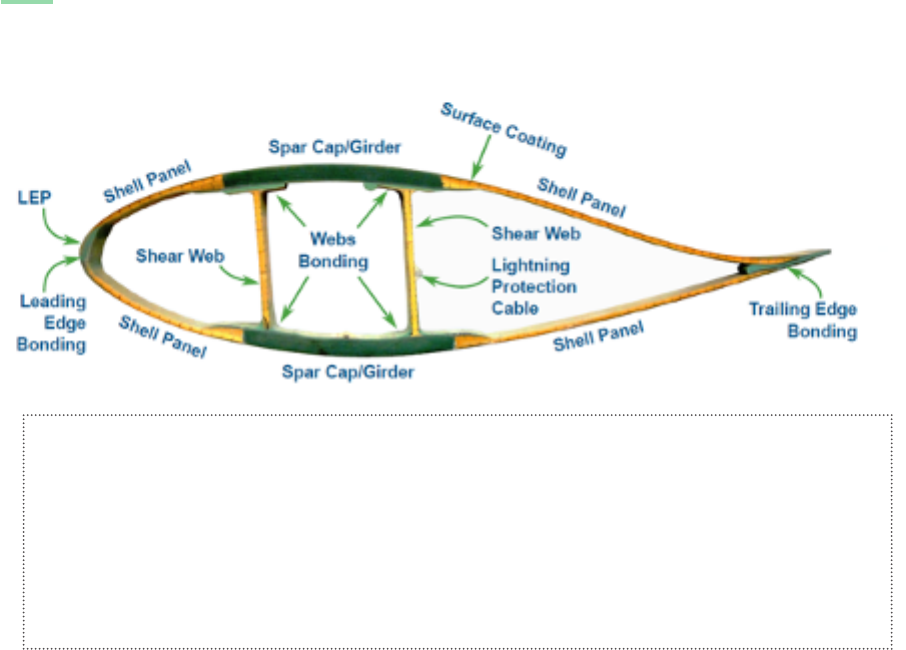
11
Accelerating Wind Turbine Blade Circularity - 2020
WindEurope – Cefic - EuCIA
Composites & the wind industry
2.2 BLADE STRUCTURE &
MATERIAL COMPOSITION
Wind turbine blades are made of composite material,
consisng of various materials with dierent properes,
which boost the performance of wind energy by allow-
ing lighter and longer blades with opmised aerodynamic
shape. Today 2.5 million tonnes of composite material are
in use in the wind energy sector globally
[1]
. Although ma-
terial composions vary between blade types and blade
manufacturers, blades are generally composed of the fol-
lowing (Figure 3):
1. Reinforcement bres e.g. glass and carbon. Glass -
bre represents the primary reinforcement material in
the composite components of wind turbine blades.
Carbon bre is also used in wind turbine blades (in
the spar), but to a lesser degree. Carbon bre’s supe-
rior strength and higher sness oers many advan-
tages over glass bre but its higher cost per volume is
a key barrier to further deployment in the wind pow-
er industry. Hybrids with a combinaon of glass and
carbon bre also exist.
2. A polymer matrix e.g. thermosets such as epox-
ies, polyesters, vinyl esters, polyurethane, or
thermoplascs.
3. A sandwich core e.g. balsa wood or foams such as
polyvinyl chloride (PVC), polyethylene terephthalate
(PET);
4. Structural adhesives e.g. epoxies, polyurethane (PUR)
5. Coangs e.g. polyester (UPR), polyurethane (PUR);
6. Metals e.g. copper or aluminium wiring (lightning
protecon system), steel bolts.
Spar Caps/Girders: Unidireconal (UD) Glass/Carbonbre, supported by Epoxy, Polyester, Polyutherane or
Vinylester matrix
Mulaxial GFRP Sandwich laminates using Balsa/PVC/PET as core material and
Epoxy, Polyester, Polyutherane or Vinylester as matrix systems
Leading/Trailing Edge and Webs Bonding: Epoy/Polyutherane based structural adhesive
Aluminium or Copper
Polyutherane based lacquer
Polyutherane based lacquer/tape
Source: TPI Composites
12
Accelerating Wind Turbine Blade Circularity - 2020
WindEurope – Cefic - EuCIA
Composites & the wind industry
The combinaon of bres and polymers, also known as
composites, represents the majority of the blade material
composion (60-70% reinforcing bres and 30-40% poly-
mer matrix by weight). In many respects, composites are
advantageous because they:
• Combine properes of high tensile strength at
relave low density (high strength-to-weight rao) to
withstand the mechanical load requirements and to
opmally perform aerodynamically;
• Provide resistance to fague, corrosion, electrical and
thermal conducvity important for the long-expected
lifeme (20 to 30 years);
• Provide exibility in design and manufacturing,
allowing to opmise the aerodynamic shape of the
blade, resulng in high turbine eciency; and
• Enable high yields resulng in lower levelised cost of
energy.
At present, wind turbine blades are made of composites
based on thermoset polymers. These polymers become
cross-linked in an irreversible process. The cross-linking is
a key requirement for obtaining the desired performance
in terms of fague resistance and mechanical strength.
Thermoplascs, unlike thermosets, do not undergo the
crosslinking. Thermoplascs are therefore more easily
recycled in simple shapes and components as they can
be melted. They have the potenal for easier recycling,
though the structural design complexity of the blades
makes it dicult. Furthermore, the mechanical prop-
eres, durability and processability of thermoplascs in
comparable price ranges currently limit their applicaons
in blades compared to thermosets.
2.3 FUTURE TRENDS IN
BLADE MATERIALS
Table 1 presents future trends in blade materials aimed
at addressing current challenges. Blade material chal-
lenges include sness opmisaon, fague life, damage
predicon methods and the producon of light weight
blade structures. Material selecon is determined by
price, process abilies, material integrity, geographical lo-
caons with more hosle environmental condions and
the demand for longer wind turbine blades. Design and
material selecon processes is rapidly evolving in order
to also consider the overall sustainability of the materials
chosen (life cycle assessment) including their impacts on
recyclability and alignment with future recycling methods
[9]
, whilst meeng the cost and performance criteria at the
same me.
Besides improving eciencies in waste collecon and
combining waste volumes, the high investment costs and
energy requirements seem to be a common limitaon to a
greater implementaon and scale-up of novel composite
recycling technologies (see Secon 5). Mulple projects
are ongoing to improve energy eciency by reducing the
process me required for the same amount of materials
and by increasing the material output of the processes.
This would translate into lower costs and allow a more ac-
ceptable energy use whilst not oseng the benets of
recycling materials. However, in order to make recycling
technologies more ecient and sustainable, the devel-
opment of these technologies needs to be coupled with
material development
[10]
.
Material innovaons should strive to have posive eects
on the producon, maintenance, lifeme and environ-
mental footprint of the blades. European technological
plaorms indicate that materials research for blades is an
important research area
[1], [11]
and see accounng for sus-
tainability and recycling as a strategic issue
[12]
.

13
Accelerating Wind Turbine Blade Circularity - 2020
WindEurope – Cefic - EuCIA
Composites & the wind industry
Design
Process modelling aimed to opmise and accurately control the
curing processes of the composites
Increased lifeme, higher conver-
sion eciency
Incorporang automased manufacturing processes to ensure
consistent material qualies and more robust manufacturing
techniques
Increased lifeme, higher conver-
sion eciency
Promong cost- and energy-ecient manufacturing processes for
carbon bre reinforced composites, since the material provides
enhanced mechanical properes. As a side benet it is also nan-
cially more aracve to recover carbon bre compared to glass
bre.
Enable manufacturing of longer
blades, hence increasing conver-
sion eciency
Introducing innovave resin/bre combinaons with improved
duclity and fague resistance
Increased lifeme
New infusible thermoplasc resins which are processed by in-
mould polymerisaon (rather than melt processing) and have
beer mechanical properes
Cost reducon
Introducing nano-components as strengthening agents in matrix
and coangs, whilst respecng HSE requirements and ensuring it
does not lead to more complex recycling methods
Increased lifeme
Invesgang bre architectures – combining high performance
glass bres, carbon bres and nano-engineered bres to make
hybrid reinforcements
Enable manufacturing of longer
blades, hence increasing conver-
sion eciency
Invesgang durable coang materials to ensure improved ero-
sion-resistance e.g. gel-coats, paint systems and tapes, resealable
and self-healing coangs
Increased lifeme, higher conver-
sion eciency
Development of bio-resins for improved performance, taking
advantage of higher availability of bio-waste
Connued availability of raw
materials and security of supply
aer depleon of fossil-based
raw materials; Reduced carbon
footprint
Developing 3R-resins – a new family of enhanced thermoset res-
ins and composites with beer re-processability, repairability and
recyclability properes
Increased lifeme; Improved
recyclability
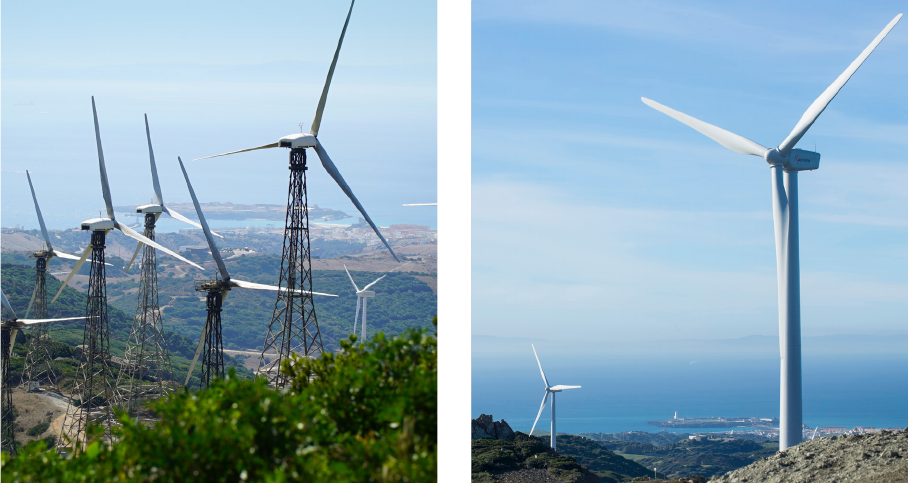
14
Accelerating Wind Turbine Blade Circularity - 2020
WindEurope – Cefic - EuCIA
3.1 AN AGEING ONSHORE WIND FLEET
Figure 4 provides a picture of the ageing onshore wind
eet. Denmark, Germany, Spain and the Netherlands are
the most mature wind energy markets. In terms of tur-
bines that are over 15 years old, these countries respec-
vely have 2.74 GW (~57%), 17 GW (~33%), more than
5 GW (~33%) and 0.6 GW (~21%).
MARKET
OUTLOOK
3.
Repowering project El Cabrito, Tarifa, Spain. Completed in 2018. It was 25 years old when dismantled
and resulted with 87% fewer turbines with the same output capacity. Source: ACCIONA.

15
Accelerating Wind Turbine Blade Circularity - 2020
WindEurope – Cefic - EuCIA
Market outlook
3.2 COMPOSITE WASTE: A CROSSSECTOR CHALLENGE
WindEurope esmates around 2 GW of wind energy ca-
pacity could be repowered and another 2 GW could be
fully decommissioned by 2023 in Europe
[4]
. This means
about 4,700 turbines (or 14,000 blades equivalent to be-
tween 40,000 and 60,000 tons) could be decommissioned
and would need to be sustainably disposed of. Recycling
these old blades is a top priority for the wind industry. This
requires certain logiscs and technology in place to pro-
ceed to disassembling, collecon, transportaon, waste
management treatment and reintegraon into the value
chain.
Composite waste amounts from the wind industry are ex-
pected to connue to increase (Figure 5). However, the
wind industry produces far less composite waste than
other industries. Based on EuCIA esmates wind will
contribute 66,000 tons of thermoset composite waste in
2025. This is only 10% of the total esmated thermoset
composite waste (and less than 5% of the total esmat-
ed composite waste combining thermoset and thermo-
plascs). Other composite-waste-producing sectors are
building & construcon, electrical & electronics, transpor-
taon, marine, producon waste, aeronaucs, consumer
and tanks & pipes sectors.
Source: WindEurope
0
10
20
30
40
50
60
Denmark France Germany Italy Netherlands Spain UK
Capacity (GW)
0-5 years
5-10 years
10-15 years
15-20 years
20-25 years
25-30 years
30-35 years
N/A
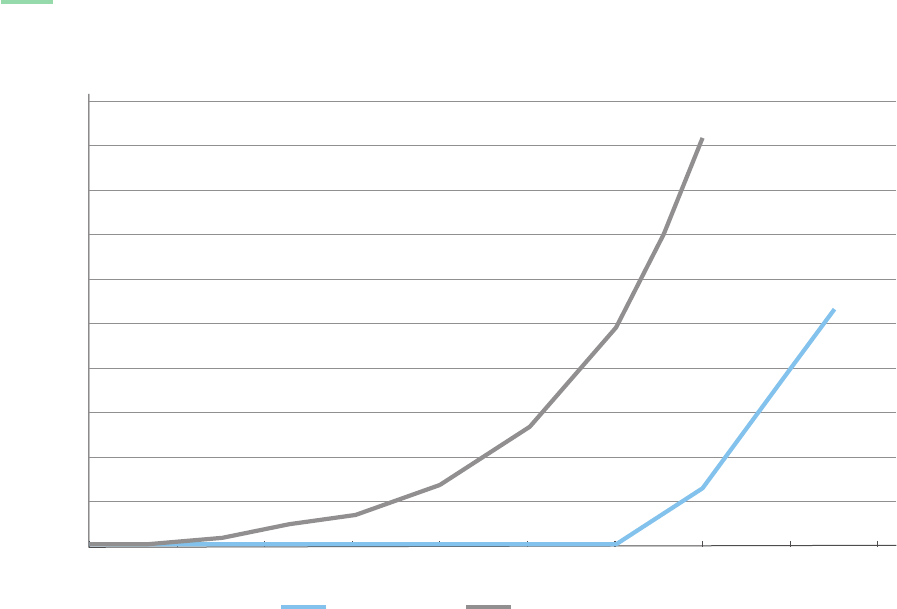
16
Accelerating Wind Turbine Blade Circularity - 2020
WindEurope – Cefic - EuCIA
Market outlook
Composite recycling is a cross-sector challenge and not
solely a challenge for the wind industry. Actually, the (low)
volumes of composite wind blade waste make it chal-
lenging to build a recycling business based mainly on this
waste stream. All the composite-using sectors must work
together to nd cost-eecve soluons and value chains
for the combined volume of composite waste. The wind
industry has already teamed up with Cec and EuCIA as
menoned above.
20 years average lifeme for wind composites. First year of commercial use of wind composites is assumed to
start in 2000. The analysis is based on global producon gures of composites as supplied by JEC and assumes global composites
producon is the same as global composites consumpon (based on thermosets only). It further assumes that as Europe’s GDP
(including Turkey) is 22%, the European consumpon of composites is 22% of the global consumpon of composites. The extrapo-
laon of certain market segments is unsure and therefore the extrapolaon of the total line does not exceed year 2025.
Source: EuCIA, 2020
Kilotons
Wind Total
1960 1970 1980 1990 2000 2010 2020 2030 2040 2050
0
100
200
300
400
500
600
700
800
900
1,000
17
Accelerating Wind Turbine Blade Circularity - 2020
WindEurope – Cefic - EuCIA
4.1 INTRODUCTION
This secon maps the exisng regulaon for composite
waste in the EU. Today, there is limited legislaon regu-
lang treatment of composite or blade waste both at EU
and naonal levels. In addion, exisng naonal legisla-
on is not necessarily aligned at internaonal level. This is
not surprising at the moment, as wind markets have de-
veloped at dierent paces. Decommissioning pracce is
only starng to emerge in those countries with a mature
market and increasing decommissioning and repowering
acvity. Generally, authories use dierent regulatory in-
struments to incenvise recycling. These include legally
binding targets, landll bans and/or taxes and require-
ments for Extended Producer Responsibility (EPR) (the
laer parcularly in other sectors). Going forward, there
may be more harmonisaon of guidelines and legislaon.
This would likely be more ecient for the development of
a pan-European market for recycling blade waste. Ideally,
there would also be alignment with other sectors of com-
posite recycling. The wind industry is ready to contribute to
that discussion. In parcular, the wind industry is currently
working on a proposal for internaonal guidelines for the
dismantling and decommissioning of wind turbines.
4.2 COMPOSITE WASTE
CLASSIFICATION
According to the European classicaon of wastes, com-
posite blade waste is
. The following other codes are also used at na-
onal level:
• 07 02 13 waste plasc from organic chemical
processes;
• 10 11 03 waste glass-based brous materials from
thermal processes;
• 10 11 12 waste glass other than those menoned in
10 11 11 from thermal processes;
• 10 11 99 wastes not otherwise specied from
thermal processes; and
• 12 01 05 plascs shavings and turnings from shaping
and physical mechanical surface treatment of metals
and plascs.
Naonal authories need to ensure the correct and suit-
able code is applied to blade waste. This would ensure
ecient separate collecon and sorng and help iden-
fy suitably authorised waste treatment opons. Having a
LEGISLATIVE
CONTEXT
4.

18
Accelerating Wind Turbine Blade Circularity - 2020
WindEurope – Cefic - EuCIA
Legislative context
waste stream that can provide clean composite of a single
type in large quanes increases the eciency of the cho-
sen waste treatment opon. However, as shown above,
composite waste is oen classied as plasc waste. It may
therefore become mixed with other types of plascs. Hav-
ing a diering waste classicaon may also limit the poten-
al for a pan-European market for recycled composites.
4.3 EXISTING REGULATION
To date, few regulatory requirements are in place for the
composite waste sector. Nevertheless, there is a clear
push towards more circularity in general at the European
level as shown by the new EU Circular Economy Acon
Plan (2020)
[13]
. The ‘European Strategy for Plascs in a
Circular Economy’ (2018)
[14]
stresses that the low reuse
and recycling rates (less than 30%) of end-of-life plascs
is a key challenge to be addressed. It sets out the vision
for ‘circular’ plascs with concrete acons at EU level. The
strategy also stresses that the private sector – together
with naonal and regional authories, cies and cizens
– will need to mobilise to full this vision. So far the focus
has been on single-use plascs, microplascs, oxo-plascs
and plascs packaging and not on composite waste.
At the naonal level, four countries make a clear reference
to composite waste in their waste legislaon: Germany,
Austria, the Netherlands and Finland. These countries for-
bid composites from being landlled or incinerated (see
Country Case Studies below). France is considering intro-
ducing a recycling target for wind turbines in its regulatory
framework (due to be updated in 2020)
[15]
.
EXISTING REGULATORY INCENTIVES
LANDFILL BANS AND TAXES
Landll bans or taxes, if well designed and correctly imple-
mented, can act as a driver to change industrial pracces.
They can dissuade disposal and smulate more circular
soluons.
When comparing the cost of recycling composite waste
with the levels of landll taxes for wind turbine blade
waste, the tax level in some countries is considered too low
to trigger substanal changes towards more recycling.
Member States have used landll bans and/or taxes to in-
cenvise avoidance of landll for dierent types of waste.
Regardless of such legislaon aecng composite waste,
the wind industry seeks to avoid landll for blade waste
treatment as per the EU’s waste hierarchy (Figure 6). It
is acvely seeking recycling alternaves, along with other
composite users.
EXTENDED PRODUCER RESPONSIBILITY
Extended Producer Responsibility (EPR) is a policy ap-
proach that has been used in other sectors to drive change
in industrial pracces. Producers are given a signicant re-
sponsibility – nancial and/or physical – for the treatment
or disposal of post-consumer products. For example, EPR
exists today for un-
der the Waste Electrical and Electronic Equipment Direc-
ve (2012/19/EU). sector has also
adopted a similar scheme since 2014.
A ban on directly landll-
ing waste with a total organic content higher than
5% came into force in 2009. Considering blades
contain an organic part (due to the resin that glues
together the glass bres), they cannot be landlled.
In response to this regulatory constraint a tech-
nical soluon was developed for handling bigger
amounts of glass bre-reinforced polymers waste
called the “cement kiln route” or cement co-pro-
cessing. A cement co-processing plant was estab-
lished in northern Germany which uses around
15,000 tons of composite waste annually, 10,000
tons of which comes from wind turbine blades. The
plant has a total current capacity of 30,000 tons/
year. Cost is around 150 EUR/t (gate fee).
Under the 3
rd
edi-
on of the Naonal Waste Management Plan land-
lling of composite waste is banned ‘in principle’.
However, wind farm operators can benet from an
“exempon” if the cost of alternave treatment is
higher than 200 EUR/t. According to a survey con-
ducted by WindEurope, the cost of mechanically
recycling wind turbine blades in the Netherlands
ranges between 500-1,000 EUR/t including ons-
ite pre-cut, transport and processing. Mechanical
recycling itself costs between 150-300 EUR/t. This
means landlling is sll pracsed.

19
Accelerating Wind Turbine Blade Circularity - 2020
WindEurope – Cefic - EuCIA
Legislative context
, the PV Cycle Distributor Take-back Scheme
(DTS) has received full government accreditaon, enabling
UK Distributors (i.e. any organisaon selling PV panels for
private households) to carry out their collecon and recy-
cling obligaons with a comprehensive support system at
reasonable cost. This means any distributor must have a
procedure in place to take back PV waste. Distributors can
choose to set up their own free take-back operaon or
join the PV CYCLE Distributor Take-back Scheme.
In other industries, EPR is taken into account by use of
Environmental Product Declaraons (EPD). These decla-
raons provide informaon on material composion and
life cycle assessment, and can also provide dismantling in-
strucons and recycling opons. For example, the use of
EPD is established in the building and construcon sector.
There is a European Standard describing the ‘core rules’
for these documents (UNE EN 15804:2012+A1:2014 Sus-
tainability of construcon works – Environmental product
declaraons – Core rules for the product category of con-
strucon products).
In France and Germany EPR for the wind industry has
been discussed (see country case studies below). In gen-
eral, wind turbine blades are very large structures and
therefore, unlike baeries, computers and PV panels, they
are unlikely to become mixed with local/municipal waste
streams. This is already recognised in the WEEE Direcve
where wind turbines are excluded because they are con-
sidered ‘Large Scale Fixed Installaons’.
the Ministry for a Just
and Ecological Transion commissioned a study on
wind turbine circularity. The report, published in
October 2019, recommended introducing EPR for
blades
[16]
. EPR responsibilies already exist in 14
sectors including end-of-life vehicles, end-of-life
ships, tyres and unused medical drugs.
The new law on circular economy adopted on 10
February 2020 extended EPR responsibilies to new
products such as toys, cigarees, texles for health-
care and building materials. Wind turbine blades
were not included in this new list. It was deemed
that EPR for wind turbine blades would not be ef-
fecve in increasing blade recycling. Instead, joint
eorts between authories and the industry were
deemed more likely to be successful.
UBA, the Federal En-
vironment Agency, commissioned a study on wind
turbine decommissioning and waste management.
Results from the study formulate recommendaons
for the set-up of an ecient dismantling system in
Germany
[3]
. This assumes among others to poten-
ally include specic elements of product responsi-
bility for Original Equipment Manufacturers (OEMs)
including:
• “Informaon and labelling obligaons re-
garding the material composion of the rotor
blades;
• Separate processing with the aim of quality as-
surance of recyclates and substute fuels;
• Obligaon for high quality recycling or guaran-
tee of disposal safety;
• Inclusion of manufacturer’s knowledge and
processing technologies adapted to prod-
uct-related technological change; and
• Cause-related allocaon of disposal costs and
organisaonal obligaons during disposal”.
However, the report also highlights the following
challenges speaking against the introducon of a
specic product responsibility for rotor blades:
• “Many wind turbine manufacturers are acve
across Europe. An isolated regulaon in Ger-
many is possible but is at odds with the funda-
mental idea of EU internal market;
• Format and storage locaon (manufacturer,
operator, authority) as well as compeon rel-
evance of the data collected;
• Long service lives of rotor blades are an obsta-
cle to an individual product responsibility; and
• The discussion on disposal opons for [glass
reinforced polymers/carbon reinforced poly-
mers] also extends to other products made of
such materials and may have to be addressed
more specically for materials ows than for
products”.
Currently, there is no iniave for legislaon in Ger-
many related to this issue. UBA is commissioning
another study on the “development of decommis-
sioning and recycling standards for rotor blades”.
The study will start in 2020 and run for 20 months.
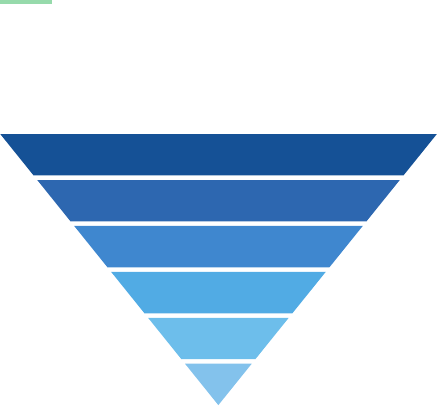
20
Accelerating Wind Turbine Blade Circularity - 2020
WindEurope – Cefic - EuCIA
5.1 THE WASTE
HIERARCHY
The European Waste Framework Direcve (2008/98/EC)
denes basic concepts related to waste management. It
emphasises the need for increased recycling and high-
lights the reduced availability of landll. It also establishes
the waste hierarchy shown in Figure 6.
BLADE WASTE
TREATMENT
METHODS
5.
Source: ETIPWind
Most prefered option
Prevention
Repurpose
Recovery
Reuse
Recycling
Disposal
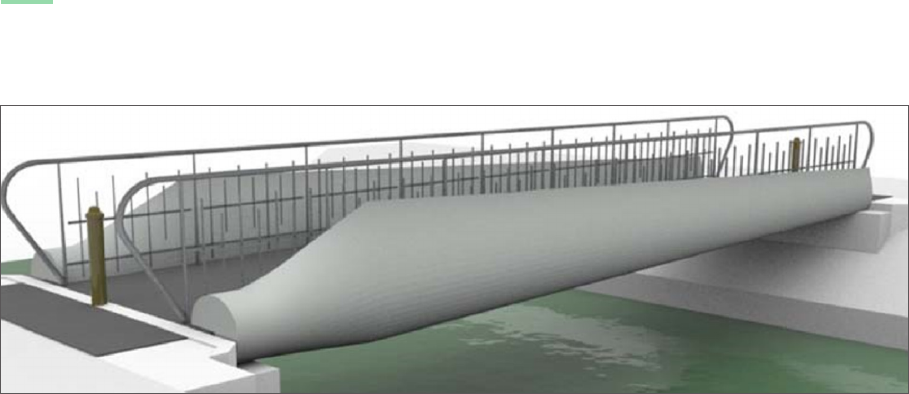
21
Accelerating Wind Turbine Blade Circularity - 2020
WindEurope – Cefic - EuCIA
PREVENTION
The wind industry is commied to sustainable waste man-
agement in line with the waste hierarchy. The rst step is
of blade waste through reducon and subs-
tuon eorts in design. For example:
• Mass reducon resulng in less material to recycle;
• Decrease failure rate and extend design lifeme.
Tesng and cercaon plays a crucial role here.
Blade failures seen in the eld are not always
triggered in the tesng phase as past standards
are not up to date for large blades (> 50m). More
recent tesng and cercaon standards like
DNVGL-ST-0376 and the upcoming IEC 61400-5 open
potenal for beer design; and
• Design for easy upgrade of exisng blade to new
versions, e.g. segmented/modular blades. However,
these are not standard design yet.
REUSE
The blade should be used and reused for as long as pos-
sible before waste treatment is needed. Roune servicing
and repair is required to achieve a blade’s design lifeme.
For lifeme extension, a ‘remaining useful lifeme as-
sessment’ (i.e. a fague load analysis using SCADA data
or types of data) must be conducted, in combinaon
with site inspecons and review of maintenance acons
performed since commissioning of the blade. This might
lead to repair acons and reinforcement of certain areas.
DNV-GL has developed a standard for lifeme extension
of wind turbines (DNVGL-ST-0262). And the Internaonal
Electrotechnical Commission (IEC) is currently developing
a standard for the through-life management and life ex-
tension of wind power assets (IEC TS 61400-28). Finally,
several European and North American companies have
established businesses for selling refurbished turbines
and components.
REPURPOSING
Repurposing is the next step in the waste hierarchy. This
means re-using an exisng part of the blade for a dierent
applicaon, usually of lower value than the original. For
example:
• Reusing the blades for playgrounds or street furniture
[17], [18], [19], [20]
.
• Specic structural parts of the blade can also be
repurposed for building structures e.g. bicycle
shelters
[21]
, bridge in Nørresundby, Denmark (yet to
be built)
[22]
, walkways, architectonic reuse
[23]
.
However, to date the repurposing examples represent
demonstraon projects that are unlikely to be a large-
scale soluon for future expected volumes.
Blade waste treatment methods
A conceptual design of pedestrian bridge using A29 wind
blades as main girders, Re-Wind research project
[24]
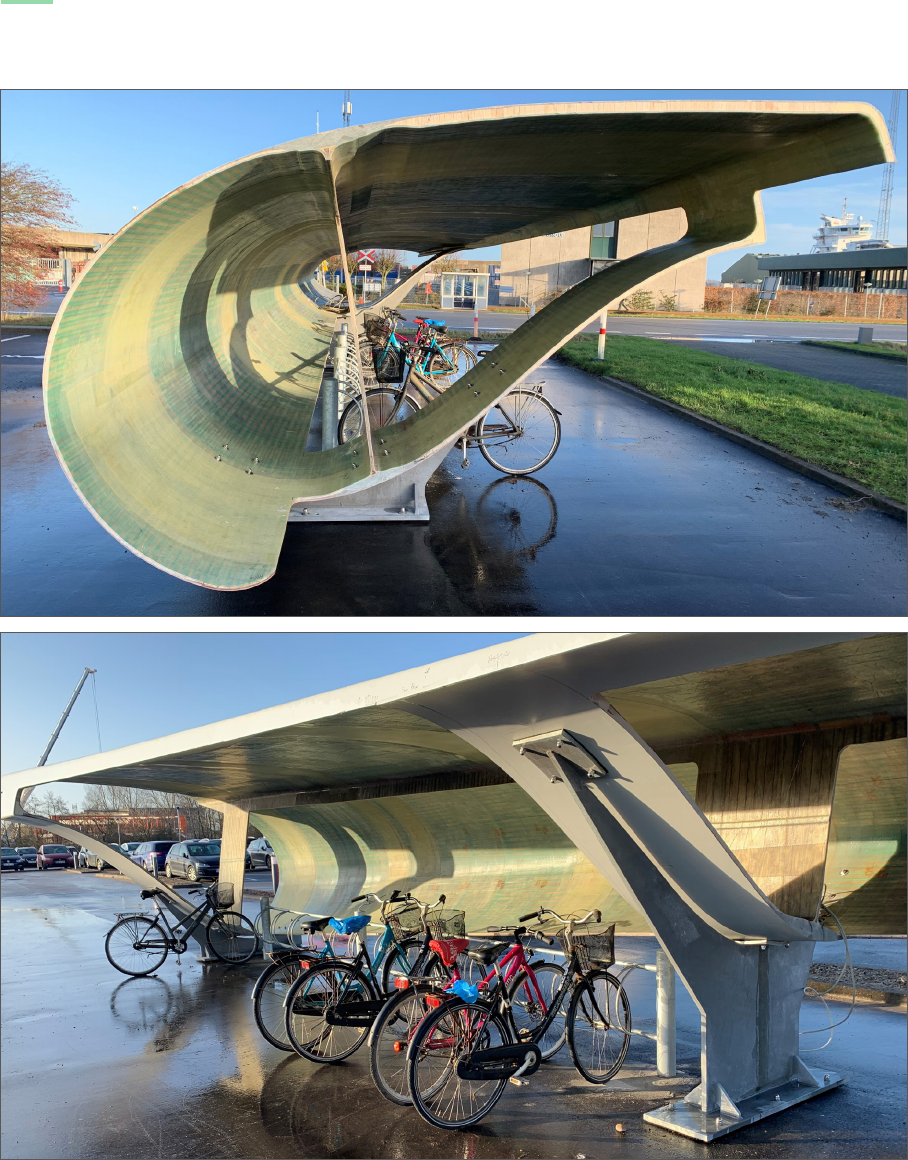
22
Accelerating Wind Turbine Blade Circularity - 2020
WindEurope – Cefic - EuCIA
Blade waste treatment methods
Source: Re-Wind and Port of Aalborg, Denmark
Bike shed in Aalborg, Denmark
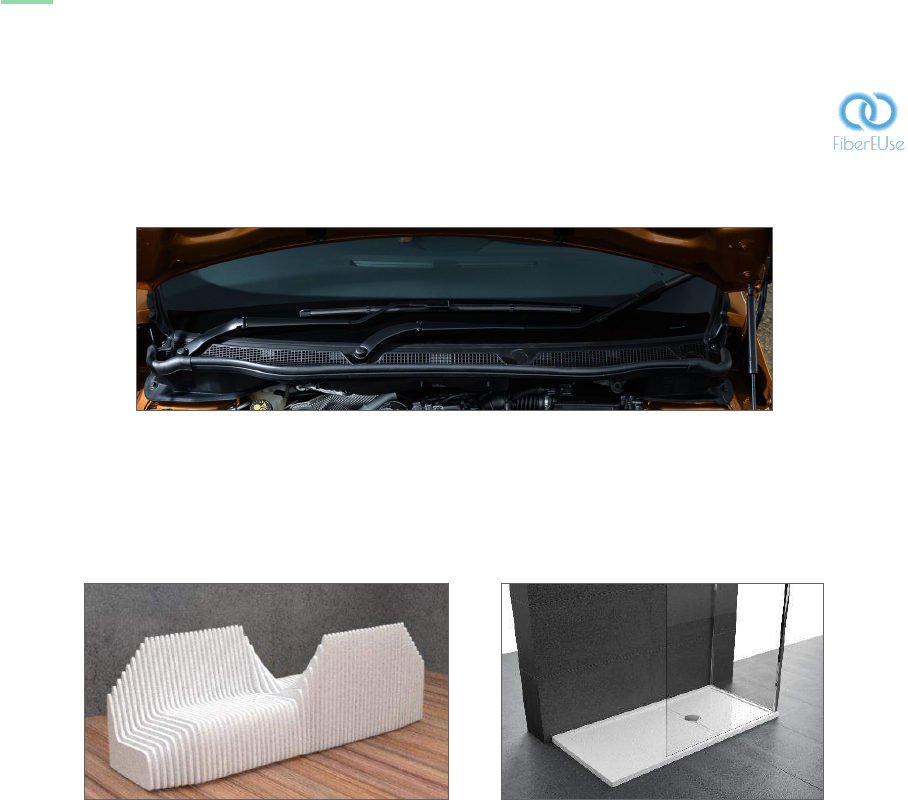
23
Accelerating Wind Turbine Blade Circularity - 2020
WindEurope – Cefic - EuCIA
Blade waste treatment methods
RECYCLING & RECOVERY
Where repurposing is not possible, recycling and recovery
are the next opons. Recycling means the blade becomes
a new product or material with the same or dierent func-
onal use. Recycling requires energy and other resources
in order to convert the blade waste into something else.
Recovery means turning waste into a fuel or thermal en-
ergy aer removing all individual components that can be
used again. Secon 5.2 describes the exisng recycling
and recovery technologies for composite waste. There is
an increasing number of companies that oer composites
recycling services. For an indicave and non-exhausve
list of companies acve in that area, you may contact
WindEurope at Sustainability-Plaorm@windeurope.org.
a) FiberEUse – Large scale demonstration of new circular economy value chains
based on the reuse of end-of-life fibre reinforced composites
Source: FiberEUse (H2020-CIRC-01-2016-2017, GA nº 730323)
Cowl tool support (automove), Maier
Modern urban furniture, DesignAustria Bathroom furniture, Novellini
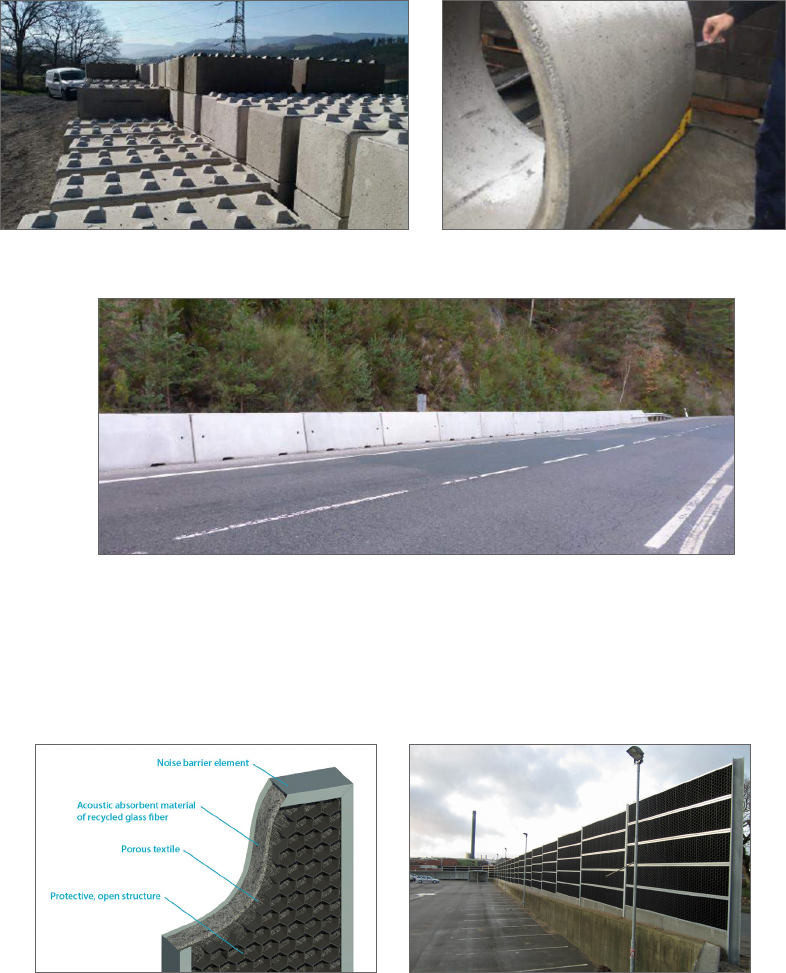
24
Accelerating Wind Turbine Blade Circularity - 2020
WindEurope – Cefic - EuCIA
Blade waste treatment methods
DISPOSAL
Disposing blades via landll or incineraon without ener-
gy recovery are the least favoured waste treatment meth-
ods because there is no material or energy recovery.
b) Mechanically recycled fibres from wind turbine blades added as short reinforcing fiber to concrete
Source: Courtesy of TECNALIA Research and Innovaon
c) Noise insulation barriers
Source: Miljoskarm
Precast concrete LEGO type blocks
Precast concrete New Jersey barriers
Precast concrete manhole module

25
Accelerating Wind Turbine Blade Circularity - 2020
WindEurope – Cefic - EuCIA
Blade waste treatment methods
5.2 RECYCLING AND
RECOVERY TREATMENT
METHODS
Today, the main technology for recycling composite waste
is through cement co-processing, also known as the ce-
ment kiln route. Composite materials can also be recy-
cled or recovered through mechanical grinding, thermal
(pyrolysis, uidised bed), thermo-chemical (solvolysis),
or electro-mechanical (high voltage pulse fragmentaon)
processes or combinaons of these. These alternave
technologies are available at dierent levels of maturity
and not all of them are available at industrial scale, as
shown by the technological readiness levels (TRL) pre-
sented in the tables below for each exisng treatment
method
[1], [25]
. The processing methods also vary in their
eects on the bre quality (length, strength, sness
properes), thereby inuencing how the recycled bres
can be applied.
The wind industry is pushing for the development and
industrialisaon of alternave technologies to provide all
composite-using sectors with addional soluons for end-
of-life. As such, the wind industry is involved in a number
of research & development projects (Appendix A).
CEMENT COPROCESSING CEMENT
KILN ROUTE
In the glass bre is recycled as a
component of cement mixes (cement clinker). The poly-
mer matrix is burned as fuel for the process (also called
refuse-derived fuel), which reduces the carbon footprint
of cement producon. Cement co-processing oers a ro-
bust and scalable route for treatment of composite waste.
It also has a simple supply chain. Wind turbine blades can
be broken down close to the place of disassembly thus
facilitang transport to the processing facility. Although it
is very promising in terms of cost-eecveness and eca-
cy, in this process the bre shape of the glass disappears
and therefore cannot be used in other composites appli-
caons
[26]
.
TRL
9
• Highly ecient, fast and
scalable
• Large quanes can be
processed
• Capability to reduce CO
2
emissions of cement manu-
facturing by up to 16%
• Slightly increasing energy
eciency of cement
manufacturing
• No ash le over
• Loss of original bre’s physical
shape
• Pollutants and parculate
maer emissions (although
appropriate migaon
exists in compliance with
the Industrial Emissions
Direcve)
• So far only suitable for
glass-reinforced composites

26
Accelerating Wind Turbine Blade Circularity - 2020
WindEurope – Cefic - EuCIA
Blade waste treatment methods
MECHANICAL GRINDING
Mechanical grinding is a commonly used technology
due to its eecveness, low cost and low energy require-
ment. It does however drascally decrease the value of
the recycled materials. The recycled products, short bres
and ground matrix (powder), can be used respecvely as
reinforcement or llers. Because of the deterioraon of
the mechanical properes, the incorporaon level of ll-
er material is extremely limited in thermoset composite
applicaons (less than 10%). For re-use of the bres as
reinforcement in thermoplasc applicaons, the variaon
in composion and potenal contaminaon with resin
parculates has a negave impact on reinforced thermo-
plasc resin manufacturing speed and thermoplasc resin
quality. This could be minimised if the separang and dis-
mantling processes were upgraded and could be suitable
in cases where no more value retenon is possible
[26]
.
TRL
• Ecient and
high throughput
rates
• Not compeve (yet) with use of virgin raw
materials
• Quality of recyclates compromised due to
the high content of other materials
• Up to 40% material waste generated during
grinding, sieving and processing
• Consequently, large volume applicaons
not (yet) developed
• Requires dedicated facilies
with closed area to limit
dust emissions
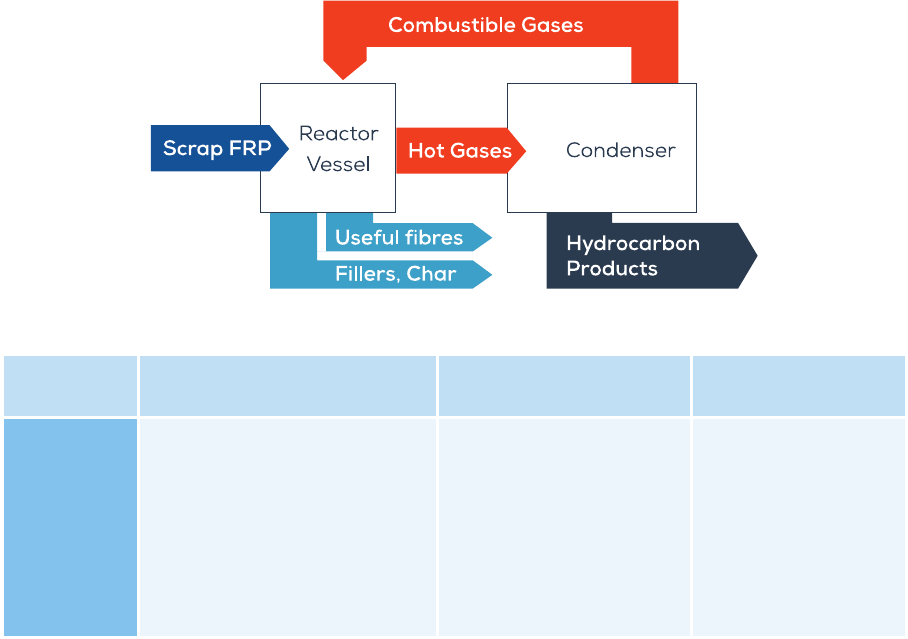
27
Accelerating Wind Turbine Blade Circularity - 2020
WindEurope – Cefic - EuCIA
PYROLYSIS
is a thermal recycling process which allows the
recovery of bre in the form of ash and of polymer matrix
in the form of hydrocarbon products. Although it allows for
the lowest value loss from industrial-scale technologies,
there is sll a loss of value. Matrices are turned into pow-
der or oil, potenally useable as addives and llers. The
bre surface is oen damaged due to the high temper-
atures, resulng in a decrease in mechanical properes.
Pyrolysis requires high investment and running costs
[26]
.
Economic viability depends on the scale and re-use that
the matrix-obtained chemicals can have. To date, this re-
cycling technology is only economically viable for carbon
bres. It is, however, not currently implemented at large
scale since the volumes of carbon bre reinforced compos-
ites are low. With the next generaon of mega-turbines,
the required weight reducon and mechanical properes
will enhance the preferred use of carbon bre composites
and the market volume might grow accordingly.
TRL
• The bi-products (Syngas and oil)
can be used as energy source or as
base chemicals/building blocks
• Easily scaled-up
• Microwave pyrolysis: Easier to con-
trol. Lower damage to the bre
• Already used at commercial scale
for recycling carbon bre compos-
ites
• Fibre product may retain
oxidaon residue or char
• Loss of strength of bre due
to high temperature
• Decreased quality of the
recovered carbon bres from
original material (lowest
value loss in comparison
to other mature recycling
technologies)
• Economically sound for
carbon bre recovery
to date
Blade waste treatment methods
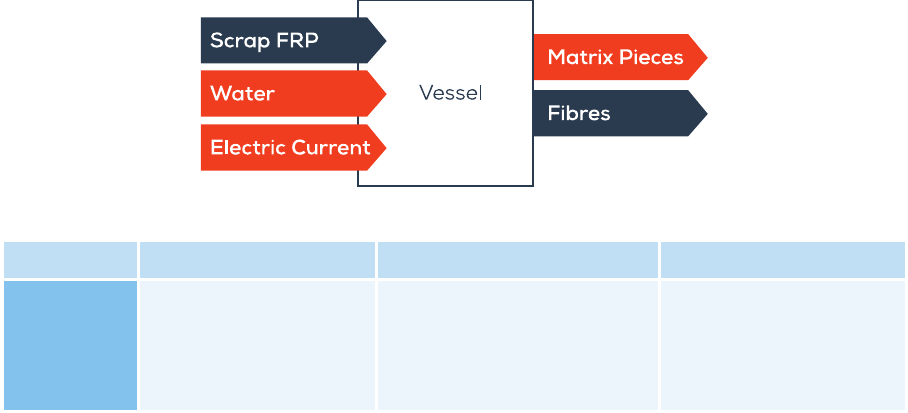
28
Accelerating Wind Turbine Blade Circularity - 2020
WindEurope – Cefic - EuCIA
Blade waste treatment methods
HIGH VOLTAGE PULSE
FRAGMENTATION
is an electro-mechani-
cal process that eecvely separates matrices from bres
with the use of electricity. However, only short bres can
be recovered from the process and obtaining quality -
bres requires high levels of energy, an issue that could
be overcome by operang at higher rates. Compared to
mechanical grinding, the quality of the bres obtained is
higher; bres are longer and cleaner
[26]
.
TRL
• Potenal to be scalable
to treat large amounts of
waste
• Low investments required
to reach the next TRL
• Only laboratory- and pilot-scale
equipment are available
• Decreased quality of the recov-
ered glass bres from original
material
• Size of the available
installaons might be
subopmal to recycle
the current stock of wind
turbine
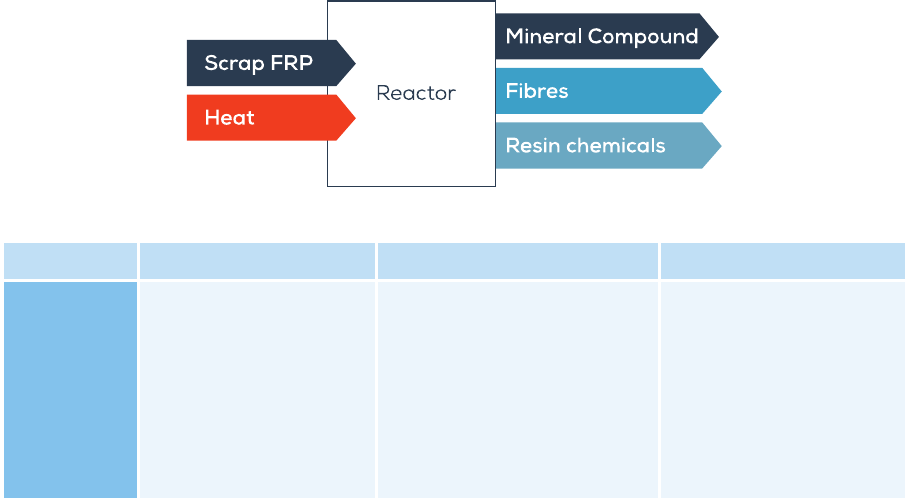
29
Accelerating Wind Turbine Blade Circularity - 2020
WindEurope – Cefic - EuCIA
Blade waste treatment methods
SOLVOLYSIS
Solvolysis is a chemical treatment where solvents (water,
alcohol and/or acid) are used to break the matrix bonds
at a specic temperature and pressure. Solvolysis oers
many possibilies due to a wide range of solvent, tem-
perature and pressure opons. Compared to thermal
technologies, solvolysis requires lower temperatures to
degrade the resins, resulng in a lower degradaon of -
bres. Solvolysis with super-crical water seems to be the
most promising technology since both bres and resins
can be retrieved without major impacts on their mechan-
ical properes. Solvolysis is easily scalable but investment
and running costs are high and it is sll at a relavely low
TRL
[26]
.
To date, only the carbon bres are recycled through sol-
volysis. However, it is not currently implemented at large
scale since the volumes of carbon bre reinforced compos-
ites are low. With the next generaon of mega-turbines,
the required weight reducon and mechanical properes
will enhance the preferred use of carbon bre composites
and the market volume might grow accordingly.
TRL
• Recovery of clean bres at
their full length
• Soup of resin chemicals
produced which can be
used as chemical building
blocks
• Low risk solvents are used
such as alcohols, glycols
and supercrical water
• High energy consumpon due
to high temperature and high
pressure of some processes
• Uses large volumes of solvents,
although these are mostly recov-
ered and reintegrated into the
process
• Decreased quality of the recov-
ered carbon bres from original
material
• To date only the carbon
bres are recycled
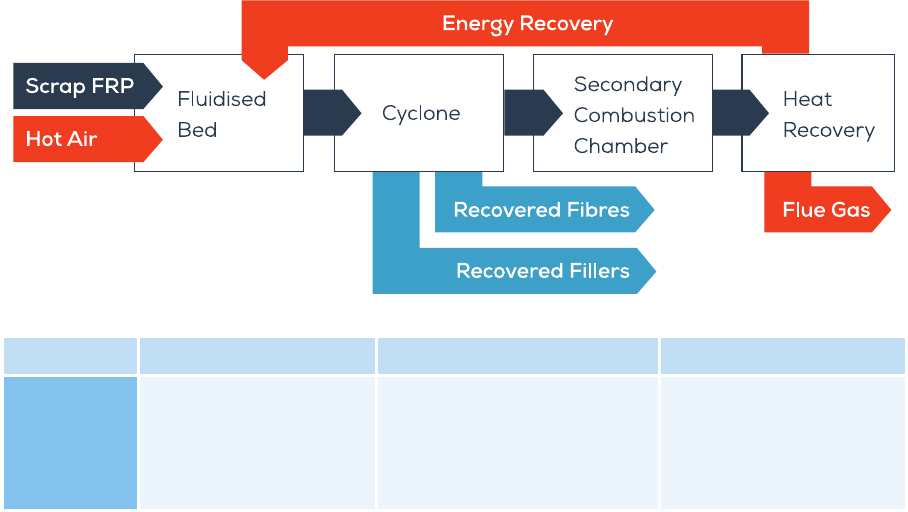
30
Accelerating Wind Turbine Blade Circularity - 2020
WindEurope – Cefic - EuCIA
Blade waste treatment methods
FLUIDISED BED
The unique characterisc of this process is that it can treat
mixed material (e.g. painted surfaces or foam cores), and
therefore could be parcularly suitable for end-of-life
waste
[26]
.
TRL
• More tolerant of contam-
inaon
• Recovery of energy or po-
tenal precursor chemicals
• High eciency of heat
transfer
• More degradaon of bres than
solvolysis/pyrolysis
• Process-related emissions
(although appropriate mi-
gaon exists)
• Scale-up sll needs to be
developed
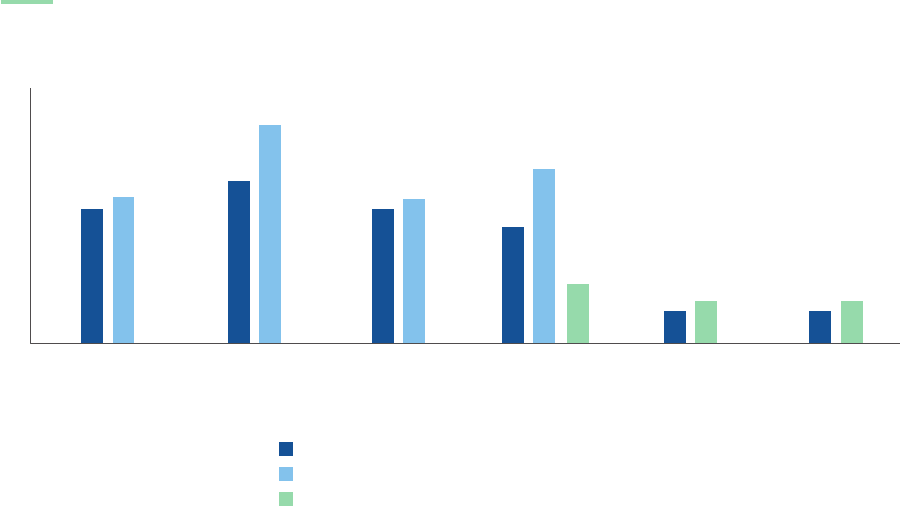
31
Accelerating Wind Turbine Blade Circularity - 2020
WindEurope – Cefic - EuCIA
Blade waste treatment methods
Today, the main technology for recycling composite waste
is through cement co-processing. WindEurope, Cec and
EuCIA strongly support increasing and improving compos-
ite waste recycling through the development of alterna-
ve recycling technologies which produce higher value
recyclates (both in terms of resin and bre) and enable
producon of new composites. Further development and
industrialisaon of alternave thermal or chemical recy-
cling technologies may provide composite-using sectors,
including the wind industry, with addional soluons for
end-of-life.
The is the one that com-
bines design, tesng (according to latest standards to de-
crease repair and failure rates), maintenance, upgrades
(e.g. reinforcement) and the appropriate recycling tech-
nology to ensure the maximal value of the material is re-
trieved throughout its lifeme. It should also systemically
allow the re-use of materials for the same or similar pur-
poses (e.g. allows polymer matrices to revert to mono-
mers and avoids bre damage during the process). Having
a good understanding of the environmental impacts as-
sociated with the choice of materials during design and
with the dierent waste treatment methods at end-of-life
through life cycle assessments will also help dene the ap-
propriate strategy.
5.3 CONCLUSION
The above highlights that while various technologies exist
to recycle glass bre and carbon bre from wind turbine
blades, these soluons are yet to be widely available at
industrial scale and to be cost-compeve. In many cas-
es, the recycled material cannot compete with the price
of virgin materials. For example the price of virgin glass
bre (1-2 €/kg) does not make the recovery of bre as
standalone product economically compeve. However,
it is envisaged that the recovery of the whole composite
materials into chemical building blocks will represent a vi-
able route. This is based on the recovery of pyrolysis oils
and of chemicals obtained through gasicaon, which is
happening in other large volume sectors and value chains
(i.e. plasc waste).
Source: Bax & Company and ETIPWind
Process Costs
Cost and value (€/Kg)
Potential material value of glass fibre
Potential material value of carbon fibre
High Voltage Pulse
Fragmentation
Solvolysis Co-ProcessingMechanical
Grinding
PyrolysisFluidised Bed
The size of the bars is indicave
and varies among EU recyclers
using the same process due to
varying process parameters such
as throughput rates/capacity,
temperature/pressure and
retenon me in the reactor.
32
Accelerating Wind Turbine Blade Circularity - 2020
WindEurope – Cefic - EuCIA
As described in previous chapters, technologies for recy-
cling composites exist. Cement co-processing is commer-
cially available for processing large volumes of waste (al-
beit not in all geographies yet). In this process the mineral
components are reused in the cement. However, the glass
bre shape is not maintained during the cement manu-
facturing process. Alternave recycling technologies are
at dierent levels of maturity and/or too expensive at
the moment, which means not all are fully commercially
available yet. The wind industry is pushing for the devel-
opment and industrialisaon of alternave technologies
to provide all composite-using sectors with addional
soluons for end-of-life products. As such, the wind indus-
try is involved in many research & development projects
(Appendix A). However, in order to succeed, it’s crucial to
consider the following:
• Increased research and innovaon (R&I) funding is
required to diversify and scale up composite recycling
technologies.
• R&I funding should also be earmarked for the
development of new high-performance materials
with enhanced circularity (design for longer lifeme,
reuse/repurpose and ‘from and for recycling’
approach).
• The scienc understanding of the environmental
impacts associated with the choice of materials
during design and with the dierent waste treatment
methods at end-of-life should also be improved (life
cycle assessment).
TAKING BLADE
RECYCLING TO
THE NEXT LEVEL
6.

33
Accelerating Wind Turbine Blade Circularity - 2020
WindEurope – Cefic - EuCIA
Taking blade recycling to the next level
The European Wind Energy Technology plaorm (ETIPWind)
had produced a brochure
[1]
on blade recycling that pro-
vides R&I recommendaons for policy makers as repro-
duced in the tables below. The SUSCHEM’s Strategic In-
novaon and Research Agenda
[10]
provides further R&I
recommendaons, parcularly on the design approach.
• Provide funding for research study comparing the economic viability of new recycling technologies, including market
barriers associated with dierent end-users
• Promote proliferaon of exisng treatment routes like cement co-processing and increase acceptance around Europe
• Set up large-scale demonstraon facilies to industrialise and scale up new recycling soluons for wind turbine blades
• Provide funding to support new manufacturing processes using recycled materials from blades in other sectors e.g. for
producon of new composites
• Establish a European cross-sectorial plaorm (including the building, transportaon and energy sectors) to share best
pracces in recycling composites
• Promote reinforcement of value chain for recycling of composite waste from all sectors
• Earmark R&I funding for the development of new high-performance materials that are more easily recyclable
• Support demonstraon facilies to test and integrate newly developed sustainable materials into next generaon
wind turbine blades
• Fund research into “smart” materials that enable beer blade designs. In addion, embed sensors in turbine blades to
enable material health monitoring and health forecasng capabilies
• Establish a full-scale demonstrator of a next generaon wind turbine using “smart” materials that help opmise main-
tenance and increase lifeme
• Encourage blade designers to consider recycling technologies and reuse opons during the process of structural de-
sign and materials selecon

34
Accelerating Wind Turbine Blade Circularity - 2020
WindEurope – Cefic - EuCIA
ETIPWind (2019) How wind is going circular: blade
recycling. Available online at hps://epwind.eu/les/
reports/ETIPWind-How-wind-is-going-circular-blade-recycling.
pdf [accessed 21 April 2020].
García Sánchez R., Pehlken A. and Lewandowski M.
(2014) On the sustainability of wind energy regarding
material usage. Acta Tehnica Corviniensis - Bullen of
Engineering Tome VII. Fascicule 1 [January – March].
ISSN: 20167 – 3809.
Umvelt Bundesamt (2019) Entwicklung eines Konzepts
und Maßnahmen für einen ressourcensichernden
Rückbau von Windenergieanlagen. Available online at
hps://www.umweltbundesamt.de/publikaonen/entwicklung-
eines-konzepts-massnahmen-fuer-einen [accessed 21 April
2020].
WindEurope (2019) Market outlook to 2023.
WindEurope (2017) Discussion paper on managing
composite blade waste.
WindEurope (2020) Wind energy in Europe in 2019.
WindEurope (2020) Repowering Trends in Europe.
www.eurofer.be/Sustainable%20Steel/Steel%20Recycling.tml
Con-Ramsden, J., Dyer, K. (2015) Materials innovaons
for more ecient wind turbines. Renewable Energy
Focus, 16(5-6), 132-133.
SUSCHEM (2019) Strategic Innovaon and Research
Agenda: Innovaon Priories for EU and Global
Challenges. Available online at hp://www.suschem.org/
publicaons [accessed 21 April 2020].
Asociación Eólica Empresarial. Observatorio Tecnológico
(2016) Innovación en el desarrollo de palas
Janssen, L. G. J., Arántegui, R. L., Brøndsted, P., Gimondo,
P., Klimpel, B. B., & Thibaux, P. (2012) Strategic energy
technology plan.
European Commission (2020) Circular Economy Acon
Plan: For a cleaner and more compeve Europe.
Available online at hps://ec.europa.eu/environment/
circular-economy/ [accessed 21 April 2020]
European Commission (2018) A European Strategy for
Plascs in a Circular Economy. Available online at hps://
ec.europa.eu/environment/circular-economy/pdf/plascs-
strategy-brochure.pdf [accessed 21 April 2020].
hp://www.consultaons-publiques.developpement-durable.
gouv.fr/projets-d-arretes-portant-modicaon-de-la-a2138.
html
Ministère de la transion écologique et solidaire (2019)
Economie circulaire dans la lière éolienne terrestre en
France. Available online at hps://www.vie-publique.fr/
rapport/271067-economie-circulaire-dans-la-liere-eolienne-
terrestre-en-france [accessed 21 April 2020].
hps://www.superuse-studios.com/projects/
rewind-willemsplein/
hps://www.superuse-studios.com/projects/wikado/
hps://www.superuse-studios.com/projects/kringloop-zuid/
hps://groenomslling.erhvervsstyrelsen.dk/
etablering-af-bro-bygget-af-genbrugte-vindmoellevinger
hps://www.energy-supply.dk/arcle/view/699757/
vindmollevinge_far_nyt_liv_pa_aalborg_havn
Erhvervsstyrelsen (2016) Etablering af bro bygget af
genbrugte vindmøllevinger.
Goodman, J. (2010) Architectonic reuse of wind turbine
blades, SOLAR 2010 Conference, ASES, May 18-22, 2010,
Phoenix, Arizona.
Suhail, R., Chen, J-F., Gentry, R., Taristro-Hart, B., Xue, Y.
and Bank, L.C. (2019) Analysis and Design of a Pedestrian
Bridge with Decommissioned FRP Windblades and
Concrete. Available online at hps://www.re-wind.info/s/
Suhail-et-al-FRPRCS14-paper-176F-2019.pdf [accessed 21
April 2020].
Bax & Company (2019). Wind turbine blade circularity:
Technologies and pracces around the value chain.
Available online at hp://baxcompany.com/wp-content/
uploads/2019/06/wind-turbine-circularity.pdf [accessed
21 April 2020].
SUSCHEM (2018) Polymer Composites Circularity.
Available online at hp://www.suschem.org/publicaons
[accessed 21 April 2020].
REFERENCES
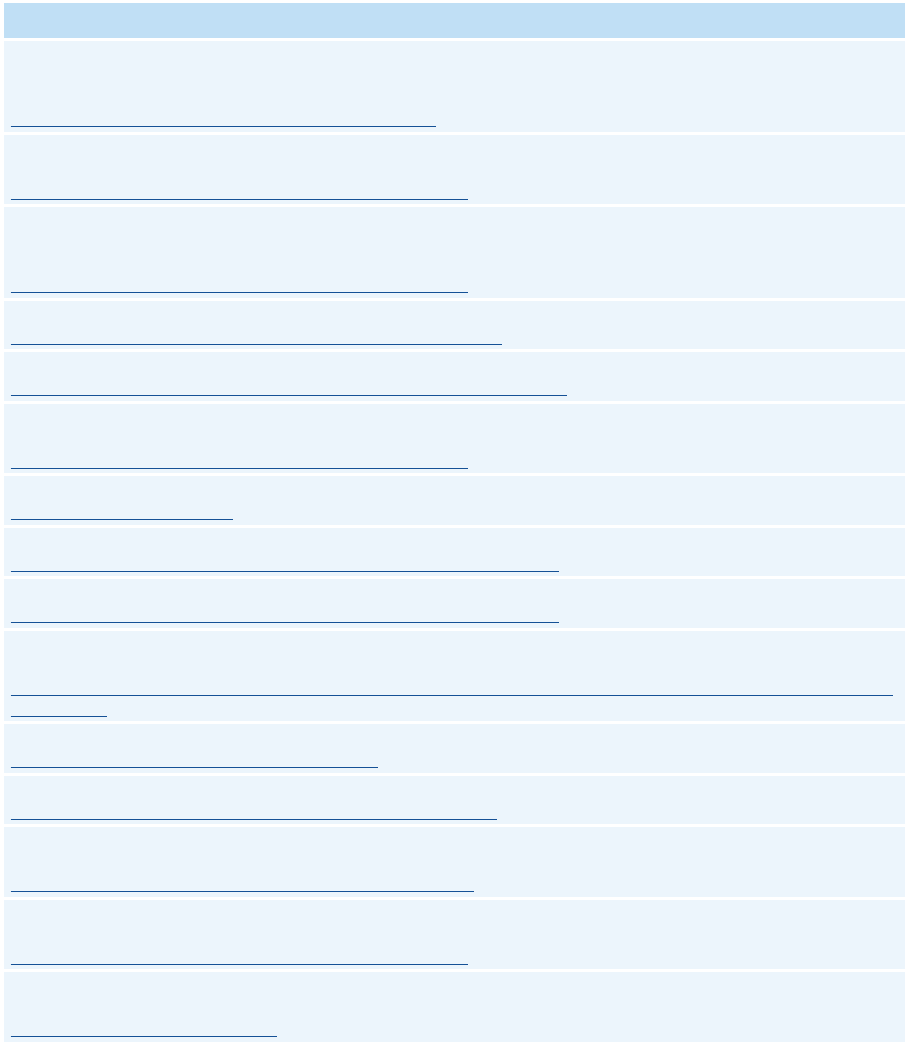
35
Accelerating Wind Turbine Blade Circularity - 2020
WindEurope – Cefic - EuCIA
APPENDIX A.
ADDITIONAL RESOURCES
Beauson, J., Brøndsted, P. (2016) Wind turbine blades: an end of life perspecve. In Ostachowicz, W. McGugan, M.,
Schröder-Hinrichs, J., Luczak, M. (2016) MARE-WINT. New Materials and Reliability in Oshore Wind Turbine Technology,
421-432. Springer
hps://link.springer.com/chapter/10.1007/978-3-319-39095-6_23
Beauson, J., Madsen, B., Toncelli, C., Brøndsted, P., Bech, J. (2016) Recycling of shredded composites from wind turbine
blades in new thermoset polymer composites. Composites Part A: Applied Science & Manufacturing, 90, 390-399
hp://www.sciencedirect.com/science/arcle/pii/S1359835X16302299
Cherrington, R., Goodship, V., Meredith, J., Wood, B., Coles, S., Vuillaume, A., Feito-Boirac, A., Spee, F., Kirwan, K. (2012)
Producer responsibility: Dening the incenve for recycling composite wind turbine blades in Europe. Energy Policy, 47,
13-21
hp://www.sciencedirect.com/science/arcle/pii/S0301421512002819
Composites UK (unknown) End of life opons
hps://compositesuk.co.uk/composite-materials/properes/end-life-opons
Composites UK (2016) Composites recycling – where are we now?
hps://compositesuk.co.uk/system/les/documents/Recycling%20Report%202016.pdf
Correia, J., Almeida, N., Figueira, J. (2011) Recycling of FRP composites: reusing ne GFRP waste in concrete mixtures,
Journal of Cleaner Producon, 19:15, 1745-1753
hp://www.sciencedirect.com/science/arcle/pii/S0959652611001880
EuCIA (European Composites Industry Associaon) - Publicaons
hp://www.eucia.eu/publicaons/
EuCIA (2011) Composites recycling made it easy
hp://csmres.co.uk/cs.public.upd/arcle-downloads/EuCIA-posion-paper-52816.pdf
EuCIA (2011) Glass bre reinforced thermosets: recyclable and compliant with the EU legislaon
hp://csmres.co.uk/cs.public.upd/arcle-downloads/EuCIA-posion-paper-52816.pdf
Hao, S. Kuah, A.T.H., Rudd C.D. & Mao, J. (2019) A circular economy approach to green energy: Wind turbine, waste, and
material recovery, Science of the Total Environment, 702:135054
hps://www.researchgate.net/publicaon/337004611_A_circular_economy_approach_to_green_energy_Wind_turbine_waste_and_ma-
terial_recovery
Jensen, J.P. (2019) Evaluang the environmental impacts of recycling wind turbines, Wind Energy, 22(2), 316-326
hps://onlinelibrary.wiley.com/doi/abs/10.1002/we.2287
Naonal Composites Network (2006) Best pracce guide: end of life opons for composite waste
hps://compositesuk.co.uk/system/les/documents/End of Life Opons.pdf
Oliveux, G., Dandy, L., Leeke, G. (2015) Current status of recycling of bre reinforced polymers: review of technologies,
reuse and resulng properes. Progress in Materials Science, 72, 61-99
hps://www.sciencedirect.com/science/arcle/pii/S0079642515000316
Pickering, S. (2006) Recycling technologies for thermoset composite materials—current status. Composites Part A: Ap-
plied Science and Manufacturing, 37(8), 1203-1215
hp://www.sciencedirect.com/science/arcle/pii/S1359835X05002101
Psomopoulos, C.S., Kalkanis, K, Kaminaris, S, Ioannidis, G.Ch. & Pachos, P. (2019) A Review of the Potenal for the Recov-
ery of Wind Turbine Blade Waste Materials, Recycling, 4(1), 7
hps://www.mdpi.com/2313-4321/4/1/7
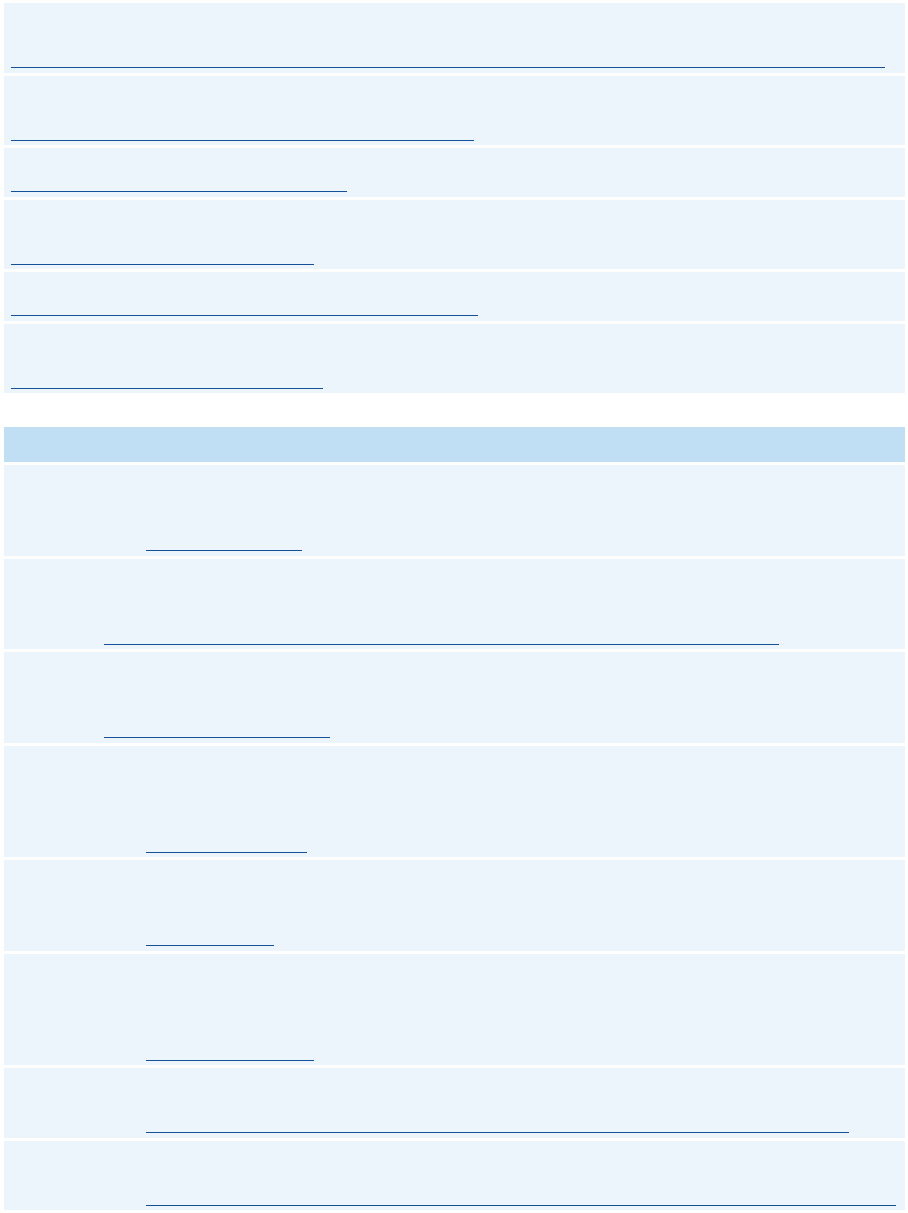
36
Accelerating Wind Turbine Blade Circularity - 2020
WindEurope – Cefic - EuCIA
Appendix A. Additional resources
Rybicka, J., Tiwari, A. & Leeke G.A. (2016) Technology readiness level assessment of composites recycling technologies,
Journal of Cleaner Producon, 112(1):1001
hps://www.researchgate.net/publicaon/303824455_Technology_readiness_level_assessment_of_composites_recycling_technologies
Shuaib, N.A., Mavenga, P.T., Howarth, J., Pestalozzi, F. Woidasky, J. (2016) High VVoltage Fragmentaon and Mechanical
Recycling of Glass Fibre Thermoset Composite. CIRP Annals of Manufacturing Technology, 65(1), 45-48.
hps://www.sciencedirect.com/science/arcle/pii/S000785061630107X
Superuse Studios (unknown) Blade Made
hps://issuu.com/2012architecten/docs/blademade
Ribeiro, M., Fiúza, A., Ferreira, A., Dinis, M., Meira Castro, A., Meixedo, J., Alvim, M., (2016) Recycling Approach towards
Sustainability Advance of Composite Materials’ Industry. Recycling, 1, 178-193
hp://www.mdpi.com/2313-4321/1/1/178/pdf
Windpower Engineering & Development (2016) Reaching rerement: recycling aging turbine blades
hps://www.windpowerengineering.com/recycling-wind-turbine-blades/
Yazdanbakhsh, A., Bank, L., (2014) A Crical Review of Research on Reuse of Mechanically Recycled FRP Producon and
End-of-Life Waste for Construcon. Polymers, 6, 1810-1826
hp://www.mdpi.com/2073-4360/6/6/1810/pdf
Introducing a novel family of ground-breaking thermoset composites that preserve all the advantages of convenonal
thermosets, but can also be easily processed and repaired and even recycled.
Date: 2018-2022 - hps://www.airpoxy.eu/
ReDisCoveR
Transform the UK’s wolrd leading composite end-of-life academic and commercial capabilies into a fully funconing and
interconnected supply chain as the edging market expands exponenonally.
Date: 2019 - hps://www.nccuk.com/work-with-us/cross-catapult-projects/rediscover-composites/?popupclosed=true
Thermal recycling process: technical and economic feasibility of R3FIBER process, obtaining high quality glass and carbon
bres in a self-sustained process.
Date: 2018 - hps://www.bcircular.com/r3ber/
Large-scale European iniave which will demonstrate that re-using, upgrading, refurbishing and recycling composite
products is possible, protable, sustainable and appealing. The project selected products in the furniture, automove and
building sectors as demonstrators.
Date: 2017-2021 - hps://www.ecobulk.eu/
Large scale demonstraon of new circular economy value-chains based on the reuse of end-of-life ber reinforced com-
posites.
Date: 2017-2021 - hp://bereuse.eu/
Re-Wind
Compare sustainable end-of-life reuse and recycling strategies for composite material wind turbine blades using Geo-
graphic Informaon Science (GIS) plaorm coupled with environmental, economic and social Life-Cycle Assessments
(LCA).
Date: 2017-2019 - hps://www.re-wind.info/
ReRoBalsa
Recycling of rotor blades in order to recover balsa wood/foam for the producon of insulaon materials.
Date: 2017-2019 - hps://www.wki.fraunhofer.de/en/departments/hnt/prole/research-projects/Recycling-of-rotor-blades.html
19 month project to develop a circular economy approach for end-of-life onshore wind turbines.
Date: 2017-2019 - hps://ramboll.com/media/environ/supporng-a-major-circular-economy-project-in-the-german-wind-energy-sector

37
Accelerating Wind Turbine Blade Circularity - 2020
WindEurope – Cefic - EuCIA
Appendix A. Additional resources
Invesgang new ways to recycle and manufacture reusable composite materials for wind turbine blades via bio-based
resources and smuli-responsive materials.
Date: 2016-2020 - hp://www.dreamwind.dk/en/
Developing demonstrators and business cases for new applicaons of secondary raw materials stemming from composite
waste streams.
Date: 2015-2018 - hps://cordis.europa.eu/project/id/646397
WaliD
Wind blade using cost-eecve advanced lightweight design, part of the project has been designing approaches for recy-
clable rotor blades.
Date: 2015-2017 - hps://cordis.europa.eu/project/id/309985
Opmising procedures for the dismantling of wind farms, taking into account the proper management of composite
waste from blades, as well as developing policy and legislave recommendaons to the European Commission.
Date: 2014-2017 - hp://www.lifebrio.eu/index.php/en/
Recycling of composite parts from plascs with matrix materials.
Date: 2014-2016 - hps://www.ivv.fraunhofer.de/en/recycling-environment/recycling-of-plasc-composites/forcycle.html
Development of new and resource ecient composite recycling and re-manufacturing processes in collaboraon with
industry.
Date: 2013-2016 - hps://www.craneld.ac.uk/case-studies/exhume
Demonstrated how composite waste can be applied in dierent products, components and structures which were based
on cradle-to-cradle philosophies.
Date: 2012-2016 - hps://www.d.dk/genvind/35154
Development of a high voltage pulse fragmentaon process for the recycling of thermoset composite materials.
Date: 2012-2014 - hps://cordis.europa.eu/project/rcn/106311/reporng/en
Mechanical recycling of aircra composites using grinding and idencaon of novel applicaons.
Date: 2011-2013 - hps://cordis.europa.eu/project/rcn/101279/reporng/en
Recycling FRP thermosets via microwave pyrolysis.
Date: 2011-2012 - hp://ec.europa.eu/environment/life/project/Projects/index.cfm?fuseacon=home.createPage&s_ref=LIFE07%20
ENV/S/000904&area=2&yr=2007&n_proj_id=3308&cd=35676&coken=f9a755eebb6457c1-BA9893A6-9033-00C6-0E8F85F614A-
2DAD6&mode=print&menu=false
Recycling FRP thermosets via solvolysis.
Date: 2009-2012 - hp://cordis.europa.eu/result/rcn/54152_en.html
Recycling FRP thermosets via mechanical processes.
Date: 2003-2005 - hp://cordis.europa.eu/project/rcn/68366_en.html
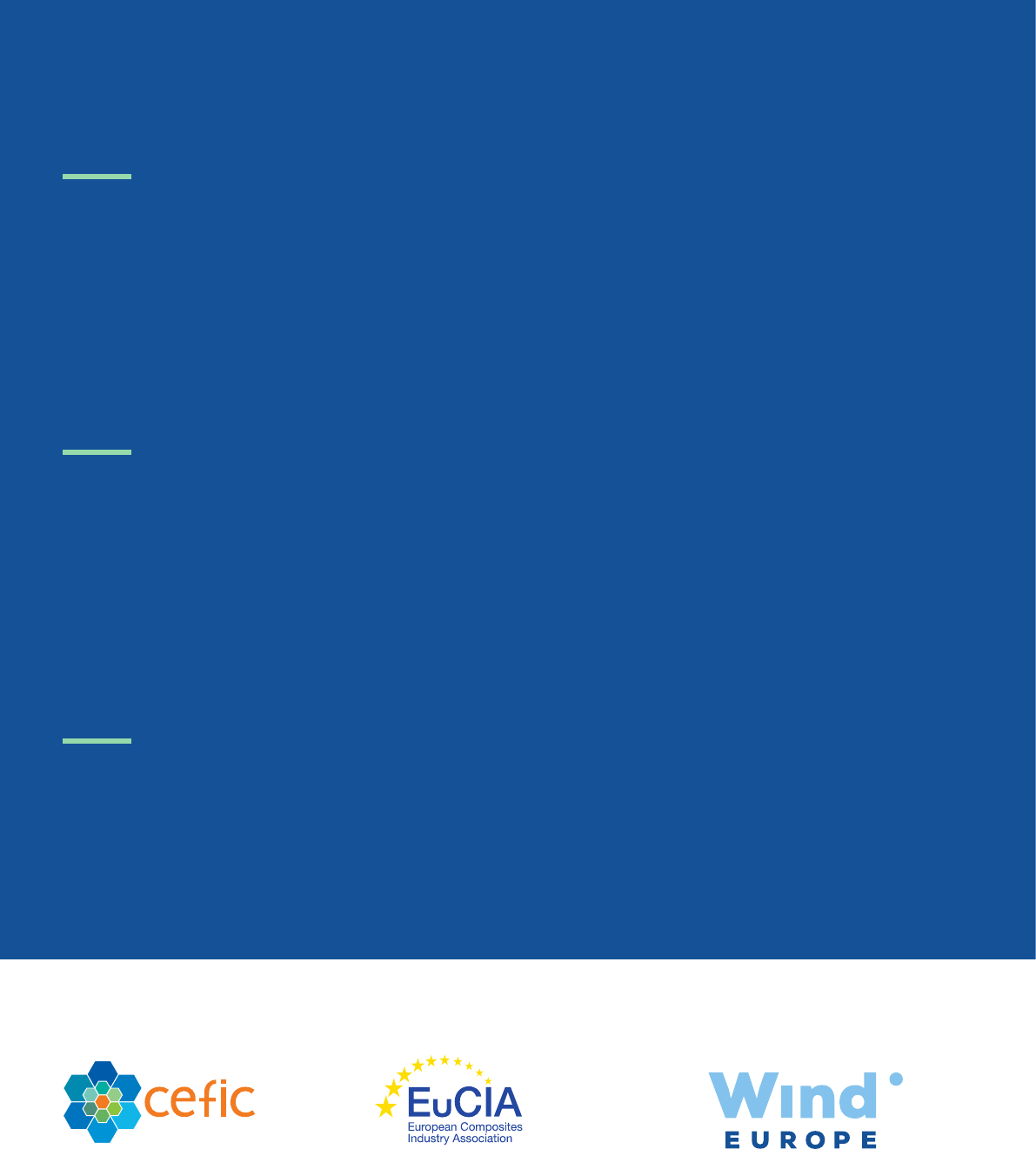
Rue Belliard 40, 1040 Brussels, Belgium
T +32 2 213 1811 · +32 2 213 1890
Rue Belliard 40, 1040 Brussels, Belgium
T +32 2 436 93 00
Bluepoint Building,
80 Bd A. Reyers Ln., 1030 Brussels, Belgium
T +32 370 89 06
Cec, the European Chemical Industry Council, founded in 1972, is the voice of large, medium and small
chemical companies across Europe, which provide 1.2 million jobs and account for about 17% of world
chemicals producon.
Cec members form one of the most acve networks of the business community, complemented by
partnerships with industry associaons represenng various sectors in the value chain. A full list of our
members is available on the Cec website.
Headquartered in Brussels, the European Composites Industry Associaon (EuCIA) represents European
naonal composite associaons as well as industry-specic sector groups at EU level. With the support
of its members EuCIA is acvely contribung to building an economically and environmentally sustain-
able European composites industry. EuCIA closely monitors relevant standards and legislaon, acvely
communicates the ways in which composites contribute to a more sustainable world, and promotes
educaonal acvies. Our iniaves aim to enable the healthy growth and connued compeveness
of more than 10,000 companies and an esmated 150,000 employees involved in composites manufac-
turing across Europe.
WindEurope is the voice of the wind industry, acvely promong wind power in Europe and worldwide.
It has over 400 members with headquarters in more than 35 countries, including the leading wind tur-
bine manufacturers, component suppliers, research instutes, naonal wind energy associaons, de-
velopers, contractors, electricity providers, nancial instuons, insurance companies and consultants.
This combined strength makes WindEurope Europe’s largest and most powerful wind energy network.
